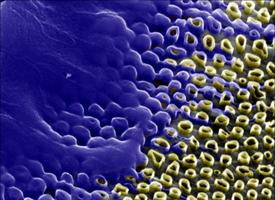
Researchers at the University of Rochester Medical Services have developed a new method for gene transfer.
Ian Dickerson, a professor in the Department of Neuroscience at URMC, says this platform has the potential to make the gene transfer process more robust and increase the diversity in the genetic cargo being delivered into cells.
Michael Schrlau, assistant professor in the Kate Gleason College of Engineering at RIT, says this new method for gene transfer is easy, affordable and efficient. He calls the process “well-tolerated by cells” while also being able to deliver DNA into tens of thousands of cells at the same time.
Thanks to new gene editing techniques, researchers are able to very precisely focus on genetic codes that allow them to fix genetic defects, alter stem cells and re-engineer them in order to fight health concerns such as infection and even cancer. There are two main concerns with the methods by which gene transfer is performed today. Firstly, the processes themselves can be extremely toxic, leaving a very minimal amount of healthy cells for scientists to work with. Secondly, current methods are very restricted in the amount of genetic information they can transfer into cells.

Schrlau Nano-Bio Interface Laboratory at RIT houses the new device outlined in the latest study. Researchers created a structure very similar to a honeycomb that contains millions of densely packed carbon nanotubes. Each nanotube has an opening on each side. This new device was built to culture a variety of both human and animal cells. After two full days, all cells were soaked within a medium containing liquid DNA. Nanotubes drew the genetic material into each of the cells. During the process, 98 percent of the cells survived. Of those, 85 percent transferred the new genetic material successfully.
Researchers believe the transfer witnessed may be thanks to a process currently known as enhanced endocytosis. This is how cells transfer proteins both into and out of the cell membrane. The device has been able to successfully culture many different types of cells, even those that are generally very difficult to keep alive after growth (including stem cells and even neurons). Scientists are currently working on optimizing this new technology in hopes that it is something that can be readily made available to researchers and help develop treatments for different diseases. This hope is promising, as the device is not very expensive to create.
Their findings were published in Small journal in April 2016. The university collaborated with the Rochester Institute of Technology.








